在中国的南方,生活着34个民族。在此,我们向您展示其中15个民族的传统服饰。
34 ethnic groups live in southern China, this exhibit showcases traditional dresses of 15 ethnic groups among them.

镶银绣花衣(正面)
苗族·20世纪80年代·贵州台江

镶银绣花衣(背面)
苗族·20世纪80年代·贵州台江
黑色绒布交领衣,土布接袖,襟边及肩、袖上绣蝴蝶、龙、牛等花纹图案。前襟下半部及后襟中央镶缀众多镂花银片、银泡、银穗等。苗族传统服饰特点为上衣下裙,重刺绣和银饰。 这是一套雍容华贵的盛装,通常在重大节庆穿着。苗族的日常生活装朴素典雅。
This Miao outfit is made of black fannel, with linen sleeves, and embroidered with butterfly, dragon, and cattle motifs. It is also ornamented with engraved silver plates, baubles, and tassels both front and back. The traditional costume of the Miao includes a shirt and skirt, eavily embroidered and decorated with silver. This costume is an outfit to be worn for festivals and special occaions. In daily life, simpler garments are worn.
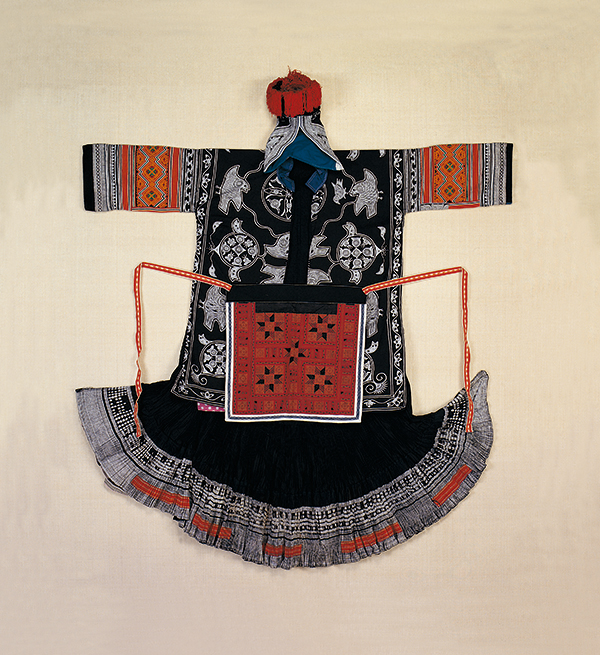
蜡染女服
苗族·20世纪80年代·贵州
苗族革家支系女服,以蜡染为特色。
This clothing is from the Gejia branch of the Miao, and is decorated with batik print patterns.
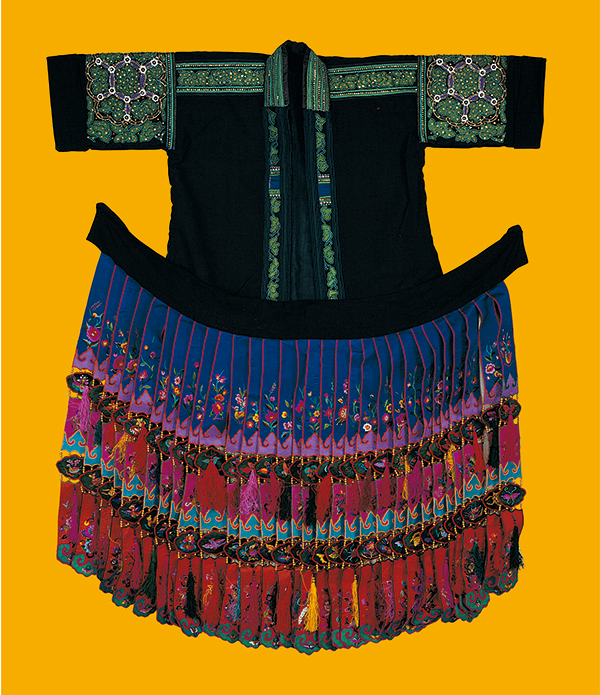
绣花盛装女服
苗族·20世纪80年代·贵州台江
上衣为自织土布辫绣衣,图案为野牡丹组成的豆角花,象征团圆。下装为平绣彩带裙。上绣野牡丹、蝴蝶、鸟、云勾等图案花纹。每条彩带分三节,蓝色上段代表清水江,中段代表长江,下段代表黄河,象征苗族先民从黄河到长江,再到现居住地清水江的迁徙路线。
The top is made of homespun cloth decorated with pigtail embroidery of wild peonies,sybolizing reunion. Each ribbon is divided into three segments: the upper represents the Qingshui River, the middle represents the Yangzi River, and the bottom represents the Yellow River. This design sybolizes the migtation route that the ancestors of the Miao followed, from the Yellow River to the Yangzi River, and eventually coming to the present home near the Qingshui River.

彩袖蜡染女服
苗族·20世纪60年代·贵州榕江
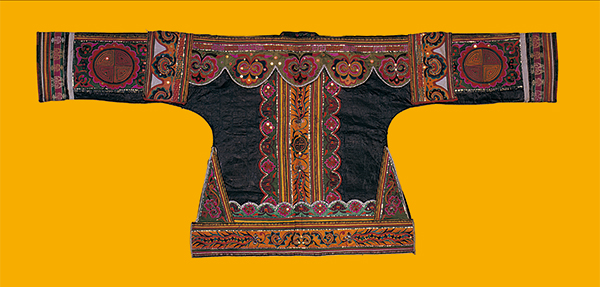
彩袖蜡染女服(上衣背面)
苗族·20世纪60年代·贵州榕江
亮布交领衣,衣袖、前襟一侧绣有少量花纹图案。背部中央及两袖、下摆处绣满彩色花纹图案。下装为土布蜡染百褶裙。
This Miao dress is made of glossy waxed cloth. The sleeves and one side of the front part of the dress are embroidered with floral patterns. There are floral designs embroidered accross the back of the jacket as well. The outfit is completed with a pleated skirt with batik designs.

蚕茧绣龙纹牯脏服
苗族·20世纪90年代·贵州台江
男子节日盛装。牯脏节上3个牯脏头人穿用。周身绣满变形龙、凤、鸟等花纹图案。绣法为蚕茧绣。即先让蚕在门板等平面物体上吐丝,形成纸张状蚕茧片。然后将其揭下,用熬好的皂角浆或魔芋粉浆粘贴于白布之上,之后再用彩色丝线绣花。
This is a costume worn by Miao men for the Guzang Festival. The three heads of Guzang will wear this costume during the festival. It is decorated with dragon, pheonix, and bird motifs, embroidered all over the garment using a special technique called "cocoon embroidery." This is made by first putting silkworms on a flat surface, the silk produced by the worms will form a peice of a cocoon which are then stuck together on a peice of plain white cloth with gum from the Chinese honeylocust fruit (Gleditsia sinensis) or konjac gell (from Amorphophallus konjac). Afterwards, it is embroidered with various paaterns using colored silk thread.
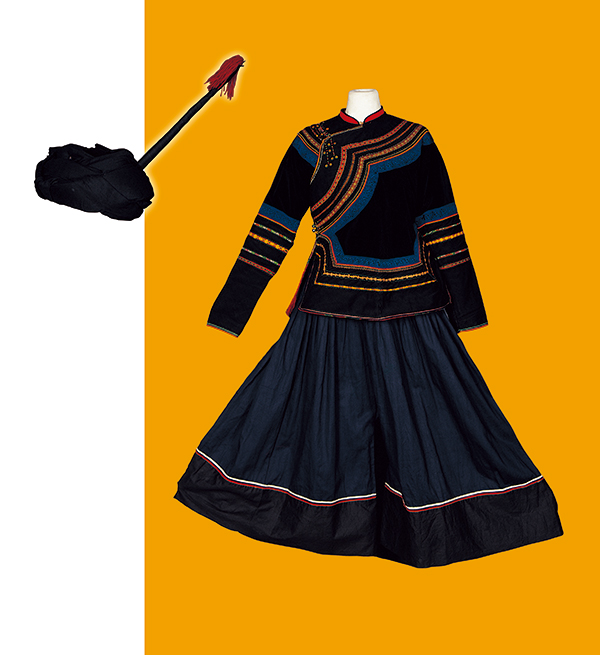
绣花中裤脚男服
彝族·20世纪50年代·四川凉山
彝族传统男服。黑色上衣镶多道彩色花边。裤腿肥大,分大、中、小三种型号,最宽者可达170厘米。头饰用黑色或深蓝色长巾缠绕而成,并裹扎出一个拇指粗的尖椎状黑角,竖立额前(俗称“英雄结”),以示英武。
This is the traditional costume of a Yi man. The black top is embroidered with colorful laces. The trousers have wide legs that normally come in a range of sizes. Yi men wear a turban made from a long piece of blue cloth. The ends of the cloth is tied into the shape of a horn to the right of the forehead. It is called “Hero Knot” and symbolizes courage .

涡旋纹彩绸黑布女服
彝族·20世纪80年代·四川凉山
彝族传统女服。右衽、短袖黑色上衣,补绣涡旋纹。下配多节式百褶长裙,腰佩三角形荷包为饰。涡旋纹,当地称“羊角花”,多用红布剪好纹样,再用黄线锁钉在黑色底布上,古朴、粗犷,特点鲜明。它是彝族传统畜牧文化的产物之一,是公羊角的艺术化表现形式。彝族的图腾为虎,黄色贴花是虎纹的体现。彝族崇尚火,红色是火的象征。
This is the traditional dress of a Yi woman. The swirl motif, locally called a "ram horn" pattern, is first cut from a piece of red cloth and then sewn onto the black cloth with yellow thread. This simple, practical and colorful pattern alludes to the traditional pastoralist culture of the Yi. The red represents fire, the yellow represents the tiger, and the black represents the clan's social status, all of which are significant in traditional Yi society.
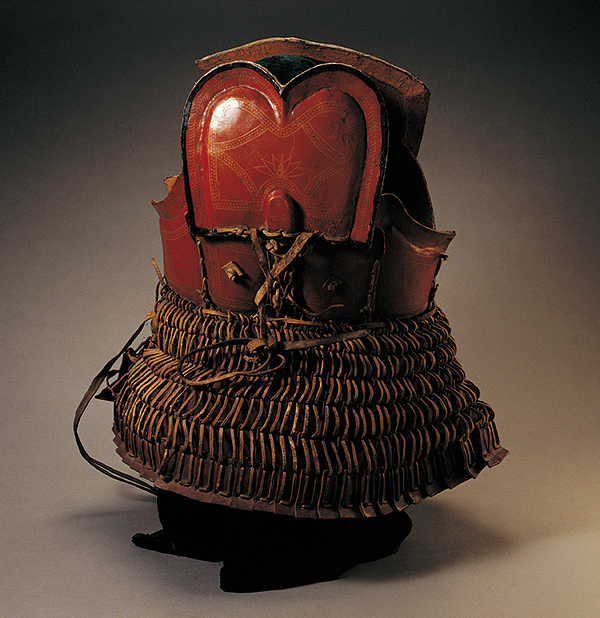
髹漆牛皮铠甲
彝族·清代·四川凉山
彝族传统护身服饰。用黄牛皮制成。整副铠甲分胸甲和背甲两大片。每片又分上下两部分,上部分前后各由5大块皮子组成,外涂彩漆,用以护胸。下半部用皮条串结小皮块而成,用以保护腹部。一侧腋下开口,以便穿着。过去,皮铠甲不仅是彝族征战械斗的防身工具,而且还是财富和特权的象征。能够拥有一副皮铠甲是个人和家族的荣耀。
This was the armor of a Yi warrior. It is made of two parts: the breastplate and the back-plate. Each plate is also divided into two parts, the upper part is composed of five large pieces of lacquered leather to protect the chest.The lower part is made of strings of leather pieces to protect the stomach. It opens on the side. It was not only worn as armor for combat, but also a symbol of wealth and power.
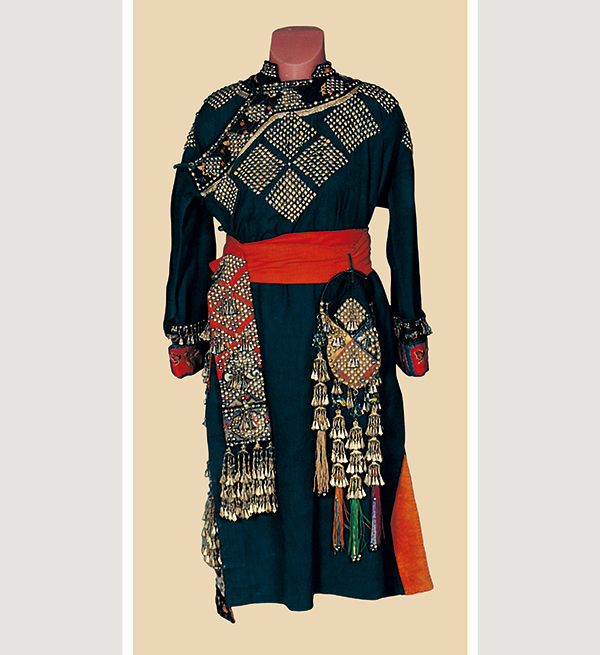
蓝布长衣
彝族·民国·云南新平
彝族传统女服。右衽蓝布长衣,后身佩镶蓝色绣花彩带,领缘、袖口及腰带上镶缀银泡等为饰。红布底,镶黄、蓝、红等色布条,并加挑方形、制钱形花纹图案。
This is Yi woman's traditional robe featuring a shoulder-fastening chest flap. The back is decorated with embroidered blue ribbons, and the collar, cuff and waistband are decorated with silver beads. This garment is made of red cloth with yellow, blue and white strips and embroidered with square and coin-like patterns.
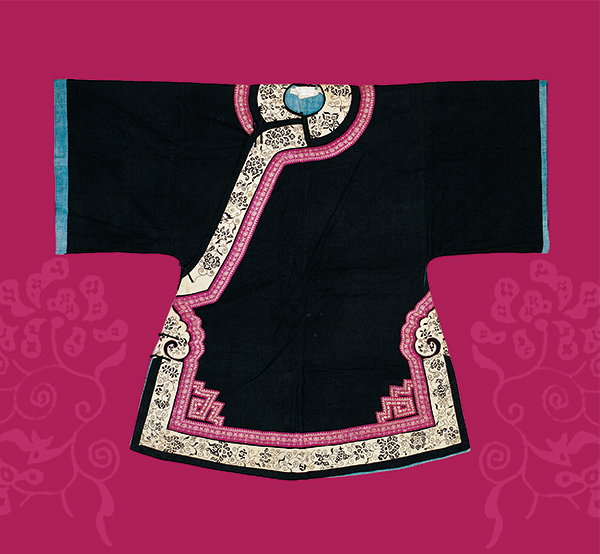
广袖青布女上衣
彝族·民国·云南武定
彝族女服。青布广袖夹衣。领缘、襟边镶绣花边两道。
This is a jacket worn by a Yi woman. The clothing of the Yi comes in a great variety local designs. This jacket is trimmed with two layers of emboridered cloth.

勾莲蝙蝠纹漳绒男袍
藏族·清代·西藏
这件藏袍为贵族男子所穿着,上绣古铜色飞龙、蓝色、茄色墩莲团花缠枝纹,莲花和龙图案寓意吉祥富贵。藏族贵族服饰质地精细,花纹讲究,一般有蟒缎袍即上面绣有龙、水、鱼、云等纹样的是官员朝见或在重大节日举行礼仪时穿用;而有莲花、凤凰纹样的缎袍,多是官员过年过节的普通藏袍。藏袍的特点为宽袍大袖,臂膀可以在袖筒中自由伸缩,一般只穿一只袖子,另一只袖子扎在腰间。且束腰带时,将下摆提至膝盖,上身提成一囊装。外出时,可将木碗等放入囊中随身携带。云龙黄金织锦面对襟大褂。襟边、袖口镶窄条毛皮边。旧时西藏地方政府官员召开会议或举行庆典时穿用。
This was the robe of a Tibetan nobleman. It is emboridered with dragons and lotus flowers to symbolize good forturne. The clothing of Tibetan nobles was made with fine materials and intricate patterns. Tibetan robes are very loose, and are usually worn with a belt tied around the waist and with one sleeve thrown over the shoulder. Although it is long enough to almost reach the ground, these robes are usually worn knee-length, with the excess pulled up by the belt in order to form a pouch that can be used to carry things like wooden bowls. It is made of golden brocade with cloud and Chinese dragon pattern; the front and the cuff are trimmed with animal fur. In ancient times, it is usually worn by local government officials in Tibet on important occasions.
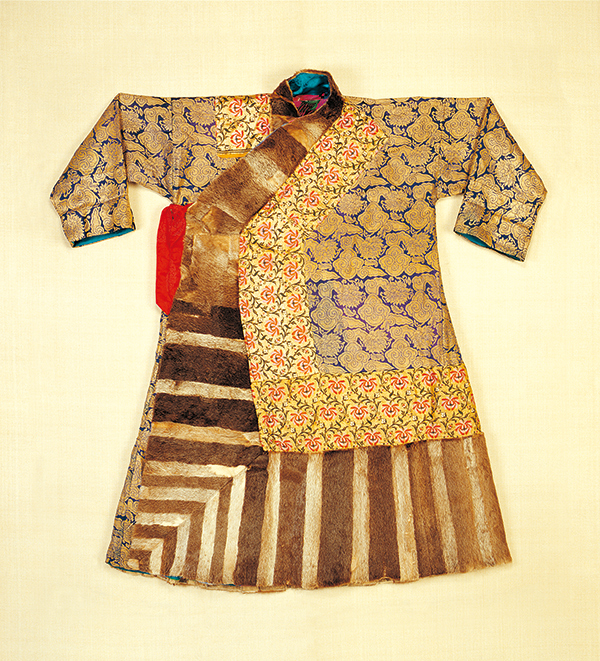
水獭皮边织锦缎女袍
藏族·民国·青海玉树
这是一件贵族妇女的袍子,织锦缎面、镶水獭皮宽边(如今,水獭已被列为国家级保护动物,禁止猎杀)。穿着时腰及大腿根部各束雕花嵌宝石银带一条。腰间一侧佩刀,另一侧垂挂佩饰。头饰用蜜腊、珊瑚等穿缀而成。
This was the brocade robe of a Tibetan noblewoman. It is trimmed with a wide band of fur from a Eurasian river otter (Lutra lutra). Today, China's otter populations are endangered and have been given national protection, ending the hunting of otters in China.The robe is worn with a decorative silver belt which is wide enough to cover the entire midsection of the robe. Robes like this were usually embroidered with flower patterns and studded with jewels. In addition to the robe, Tibetans usually wear a dagger on one side and accessories on the other side, tucked into the belt. The headwear is decorated with precious stones such as amber and coral.

豹皮边氆氇男袍
藏族·清代·青海
紫红色氆氇面、豹皮镶边男袍。藏袍的基本特点是多以氆氇、羊皮或锦缎为原料。大襟、右衽、腰襟肥大、袖子宽长,衣领、襟边、袖口、下摆等处多以细毛皮、氆氇或色布镶边。穿着时,用皮、绸缎或银腰带束腰。既美观大方,又适宜高原复杂多变的气候条件,穿脱方便,利于劳作。
This is a Tibetan robe made of rich purple wool with leopard fur trim (probably from Pantera pardus delacouri). Tibetan robes are worn loose, with long, wide sleeves. They are usually made of wool, sheep skin or brocade. The collar, cuffs, and hem are usually trimmed with fur, wool or colorful cloth. This kind of robe is easy to put on, take off, or can be worn with one shoulder exposed, versatility that is suitable for doing hard work in Tibet's volatile weather.
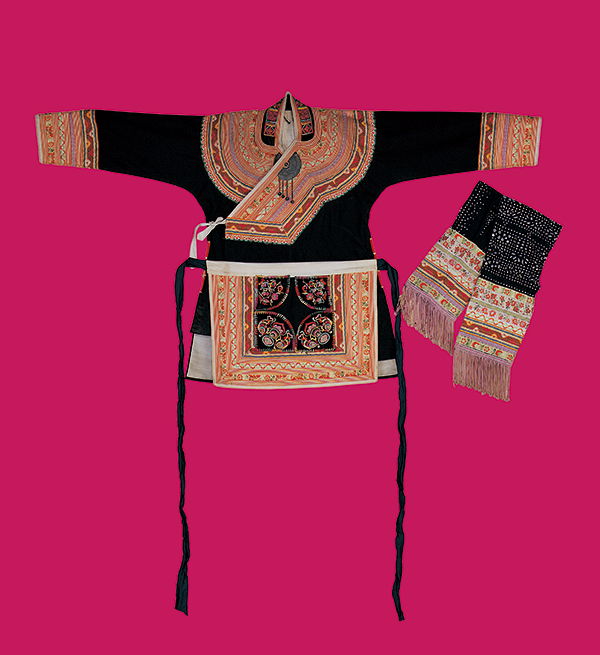
大襟绣花衣
畲族·清代·福建
黑色土布大襟衣,领缘、袖口、围腰上均彩绣花纹,蜡染腰带两端绣有花边,缀有流苏。 这是福建畲族妇女最具特色的传统服饰叫“凤凰装”,在服装和围裙上刺绣着各种彩色花边,象征着凤凰的颈、腰和美丽的羽毛。头上还用红头绳扎发髻,高高地盘在头上,象征着凤凰的头。关于凤凰装的来历,有一个美丽的传说。相传畲族始祖盘瓠王因平藩有功,高辛帝将心爱的三公主嫁给他,结婚时,帝后娘娘送给女儿一顶非常珍贵的凤冠和一种镶有珠宝的凤凰衣,祝福女儿像凤凰一样给生活带来吉祥如意。三公主婚后生下三男一女,当他的女儿长大出嫁时,美丽的凤凰从广东凤凰山衔来了五彩斑斓的凤凰装,从此,畲族的妇女就穿上了象征吉祥幸福的凤凰装。
This type of dress is worn by the She women in Fujian Province, and is called a Phoenix Dress. The colorful lace embroidery represents the phoenix's neck, waist and beautiful feathers. Women coil their hair on the top of the head and tie it with red wool thread, symbolizing the phoenix's head. There is a legend about the origin of the Phoenix Dress, that long ago, King Gaoxin married his third daughter to Panhu, the ancestor of the She people, as a reward for a victory in battle. The Queen sent a phoenix crown and a phoenix dress to the Thrid Princess along with her best wishes for a happy life. Afterwards, the Third Princess gave birth to one girl and three boys. When the girl married, a phoenix came back from Phoenix Mountains with the shinning Phoenix Dress in its beak. Since then, the She women have made it a tradition to wear the Phoenix Dress as a blessing.
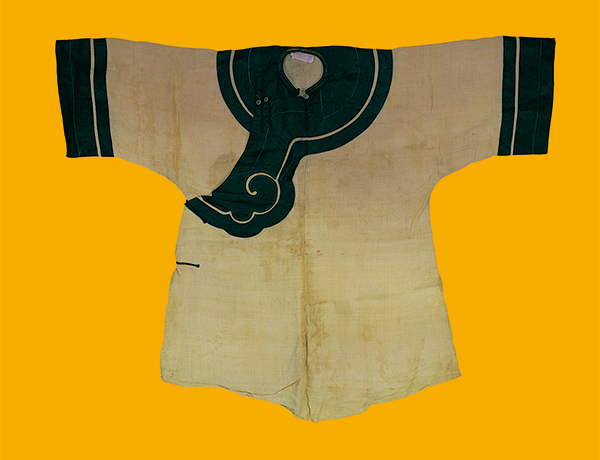
麻布广袖大襟衣
畲族·民国·广东潮安
麻布制,领缘、袖口、襟边镶黑布边。青色麻布上衣,对襟、无领、无扣。襟缘镶珠子及彩色丝穗,下摆缀铜铃、铜钱为饰。筒裙用色线手工织成,以几何图案为主。
This jacket is made of gunny cloth with black trim around the collar, the cuffs and accross the front hem. This is the traditional clothing of a Li woman. The top is made of indigo sackcloth without a collar or buttons, while the lappel is trimmed with beads and colored tassels. The hem of the top is trimmed with copper bells and copper coins. The tight skirt below is embroidered with multi-colored threads in geometric patterns.

镶银绣花女服
拉祜族·20世纪80年代·云南澜沧
黑色平绒布制成。衣襟、下摆、袖子上镶银泡和花边为饰。筒裙上绣船形纹、波浪纹等图案。自织土布制成。领、襟、袖口镶红、黄、蓝边及黑、白等色布拼成的花纹。
This Lahu dress is made of black velveteen, decorated with silver balls and embroidered patterns around the collar, cuffs and hem. The skirt is usually embroidered with wave-like patterns that evoke fields of grain. The Lahu robe is made of hand-woven cloth, embroidered with intricate designs in red, yellow, blue, white, and black on the collar, lapels, and at the hem.
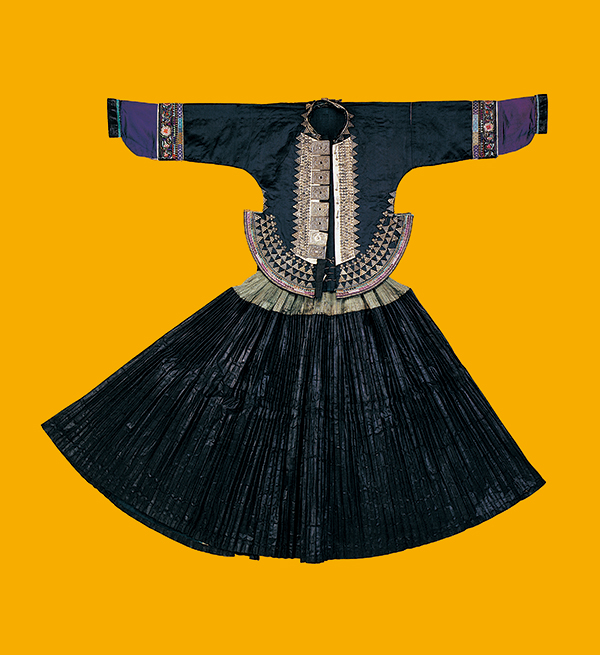
镶银圆摆女服
壮族·清代·云南文山
壮族是一个尚黑的民族,这件青绸对襟衣,衣袖束口、镶蓝绸和绣花边各一段。襟边和圆形下摆处镶缀银片、银泡等为饰。裙为黑色百褶长裙。
The color black has great significance to the Zhuang. This green silk blouse is front opening, with close-fitting cuffs and is decorated with blue silk and embroidered lace. The front edge and the hem are decorated with silver plates balls. The long skirt is a black and pleated.

镶边麻布女服
傈僳族·清代·云南丽江
这套服装是傈僳族妇女亲手将麻采来,经过许多道工序加工纺织而成的。全部工序都是用手工来完成。绩麻织布是每个傈僳族妇女必备的本领,一般女孩从十一二岁就开始学习纺麻织布,麻布虽不如棉布柔软,但麻布挺阔,透气性好,不怕潮湿,非常适合在炎热、湿润的南方穿用。
This Lisu dress is made of linen. Spinning and waving linen was an important skill learned by every Lisu woman. Girls begin learning to spin thread as children. Though linen is not as soft as cotton, it is strong, breathable, and moisture resistant, and well suited to the hot and humid climate of southwestern China.
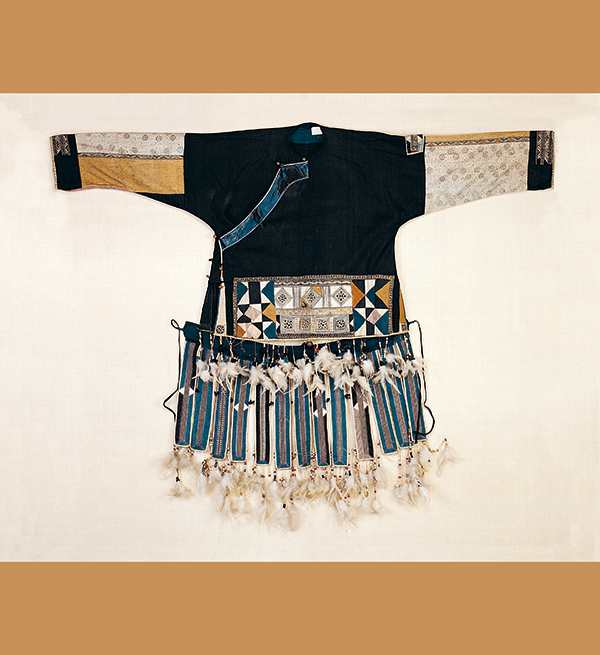
百鸟衣
侗族·清代·广西三江
蓝色侗布衣,色布拼袖,前后襟下摆处用色布拼有方形、菱形、三角形图案,下缀铜铃及羽毛。下为彩带鸡毛裙。男子喜庆吉日跳芦笙舞时穿用。
This is a blue jacket made by the Dong. It is made of dark cloth and patches of lighter cloth adorning the sleeves.The bottom is trimed with square, diamond, and triangular patterns, and copper bells and feather hang from the fringe. The outfit is completed with a skirt that is decorated with ribbons and feather. This outfit is worn by men for the "lusheng" dance during major festivals.
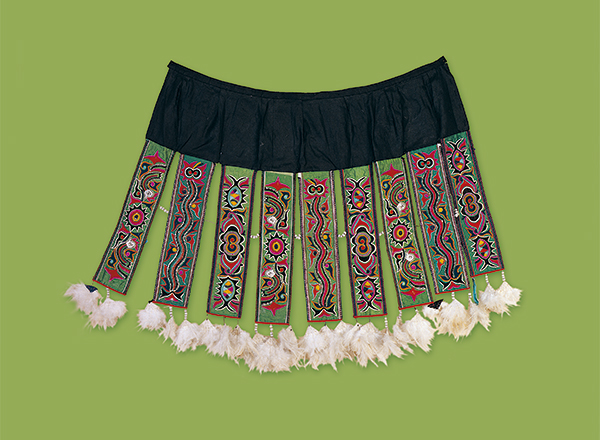
彩带鸡毛裙
侗族·20世纪80年代·贵州
黑色裙腰、绿色裙带,上绣变形鱼、龙、鸟和太阳纹等图案。
This skirt would have been worn by a Dong woman. The black waistband and green strips are embroidered with fish, dragon, and sun motifs.
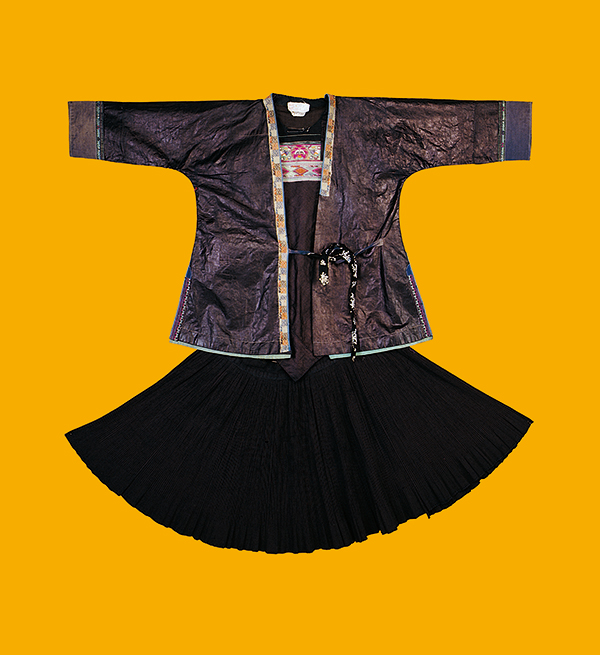
亮光土布女服
侗族·清代·广西三江
侗布制,交领、无扣,以布带一对系结。襟边镶彩色花边,内罩绣花胸兜,下着百褶裙,外系围裙。侗布由妇女手工纺织、靛染而成,分平纹布、斜纹布、花椒眼布、辫纹布等多种。染好的布再用稀牛皮胶浸泡,或涂抹一层薄薄的蛋清,用木锤反复捶打,布色会更加鲜艳光亮。
The dress is made of purple glossy hand-woven cloth with cross collar and no button, hitched by a pair of cotton tapes. It is trimmed with colorful laces, matched with embroidered bellyeband inside, pleated skirt and apron outside. Dong cloth is woven and dyed by hands, which can be divied into plain cloth, demin, Chinese prickly ash eyes cloth, plait grain cloth etc. After soaked with diluted cattle glue or applied a layer of egg white, repeatedly beaten with a wooden hammer, then the color of the cloth will be brighter.
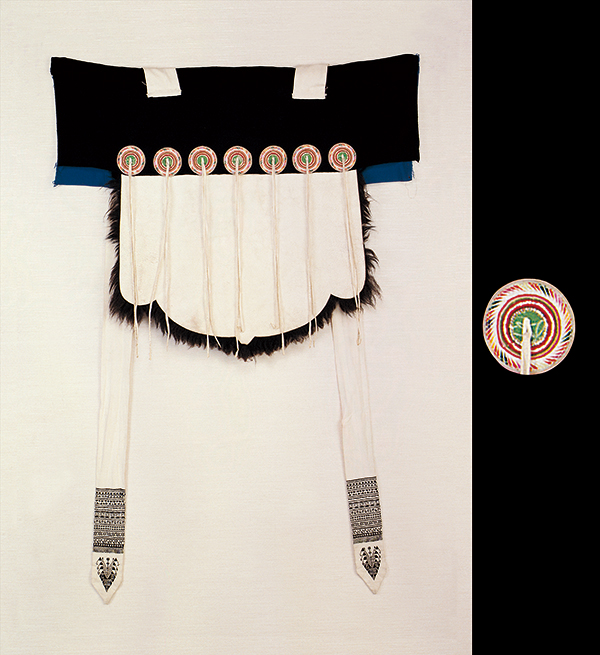 、
、
七星羊皮黑呢披肩
纳西族·民国·云南丽江
俗称“披星戴月”或“七星披肩”。用羊皮和黑毛呢制成。羊皮上端7个绣花圆盘代表七颗星,有的上端还缀有两个大圆盘,代表日月,象征纳西族妇女“肩担日月,背负繁星”,整日起早贪黑辛勤劳作的美德。这种经过剪裁、形似蛙状的披肩,实际上是纳西族蛙图腾崇拜在服饰上的表现,也是其先民古羌人游牧文化的一种遗存。
This is a Naxi cape made of sheepskin and black wool. The seven round patterns represent seven stars and the two upper ones represent the sun and the moon. Together they symbolize the spiritual nature of the Naxi but also allude to the daily lives of Naxi women, who rise in the morning while the stars are still in the sky, and work until the moon comes up in the evening. The cape is also meant to resemble a frog, an important totem in Naxi shamanism, representing the roaming and nomadic life of the Naxi's ancestors before they settled.
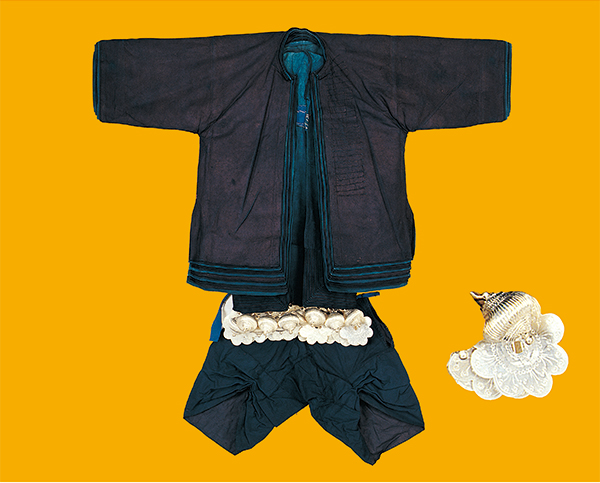
青黑色土布女服
哈尼族·20世纪70年代·云南红河
哈尼族叶车人传统女服。用自织自染的青黑色土布制成。下身为短裤,上身缀银饰者为汗衫,只在节日或待客时穿。外衣无领无扣,下摆呈扇形,一般均多层套穿,里长外短,多者可达12层。她们认为,层数越多越美,越多越显示富有。
These are the traditional clothes of a Yeche woman, a branch of Hani. The black cloth is hand woven and dyed.Yeche women wear shorts and collarless jackets with silver ornaments at the waist. The jackets are worn in many layers. The greater the number of layers, the greater the wealth of the woman wearing it. This particular garment has 9 to 12 layers.

箭毒木树皮衣
哈尼族·民国·云南勐腊
哈尼族树皮衣为箭毒树皮所制。制作方法是:选择粗直的树木,先用木锤将树皮锤松后把树砍倒,从树干上褪下完整的树皮筒,然后把树皮筒放在清水中揉软,再用树枝将其撑开晾晒。之后即可剪裁缝制衣裤等物。这是人类早期服饰的残余形式之一。过去云南西双版纳地区的哈尼、傣等民族中均较为常见,现在已无人穿着。
This is an example of Hani clothing made of curare bark.The bark cloth is made from the bark of a tree with a thick, straight trunk, which is peeled from the trunk after the tree is cut down, then rubbed with water to soften it and laid out to dry in the sun. Once it is processed, the bark can be cut and sewn into clothing. This is one of the most ancient surviving techniques for making clothing and in the past it was very popular among the Hani and Dai in Xishuangbanna, Yunnan. Today, though, the art of making clothing from bark has been completely abandoned.
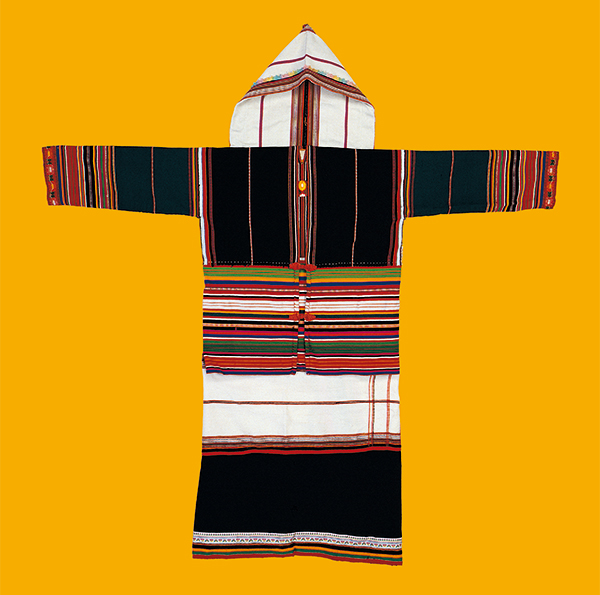
尖顶帽短款女服
基诺族·20世纪50年代·云南景洪
用自织土布制成。上衣对襟、无领、无扣,内罩胸兜,下为短筒裙,上为三角形尖顶帽。
This is a set of clothes worn by a Jino woman. It is consists of a short, collarless and buttonless jacket made of woven cloth, with a sash underneath, a short tight skirt and a pointy hat.

纽扣衣
高山族·民国·台湾
无领、无袖,彩色绒面绣花、饰钮扣短衣。
This vest has neither collar nor sleeves, and is decorated with embrodery and buttons.
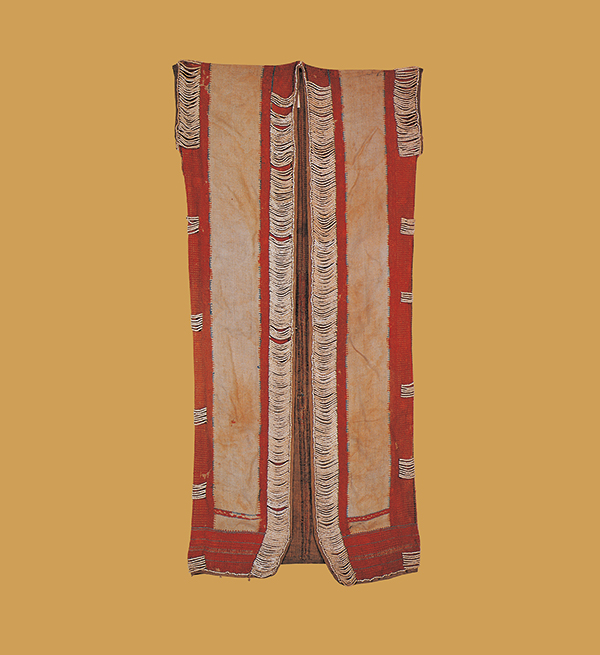
贯头麻布贝珠衣(正面)
高山族·清代·台湾
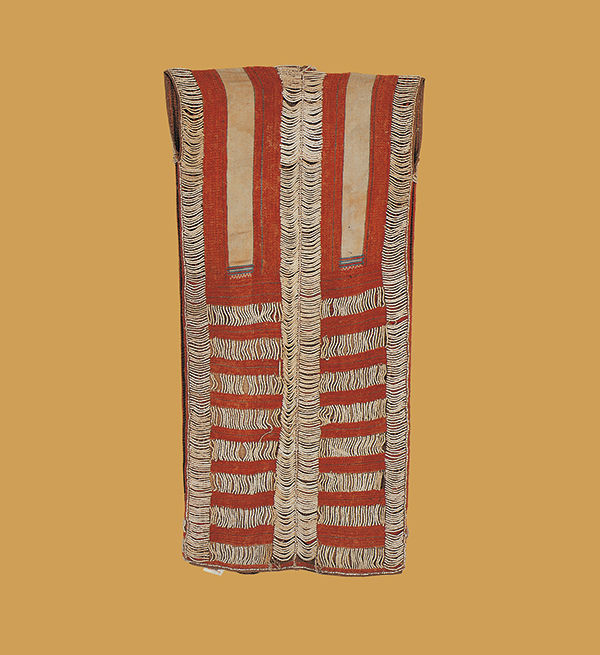
贯头麻布贝珠衣(背面)
高山族·清代·台湾
以两幅麻布制作的无领、无袖长衣为底,上面缝缀一串串的贝珠制成。其制作方法,一般是先将砗磲贝切成颗粒状,然后磨成贝珠,再将其一粒粒地穿缀成串,缝饰在麻布衣服的襟边、袖口、背部,乃至全身。每件衣服需用贝珠几万颗至十几万颗之多,它是权力、地位和财富的象征,只有头目、族长或猎首最多的勇士才能穿用,还常被作为聘礼和货币使用。
This is is a linen vest, sewed from two pieces of sackcloth, decorated with strings of beads. To make such a dress, people harvested giant clams and ground them into shell beads. It takes tens of thousands of shell beads to make such a dress. Only the tribal chiefs or heroes were allowed to wear it. It is a symbol of power, status and wealth. In the past, it can also be used as a betrothal gift or money.
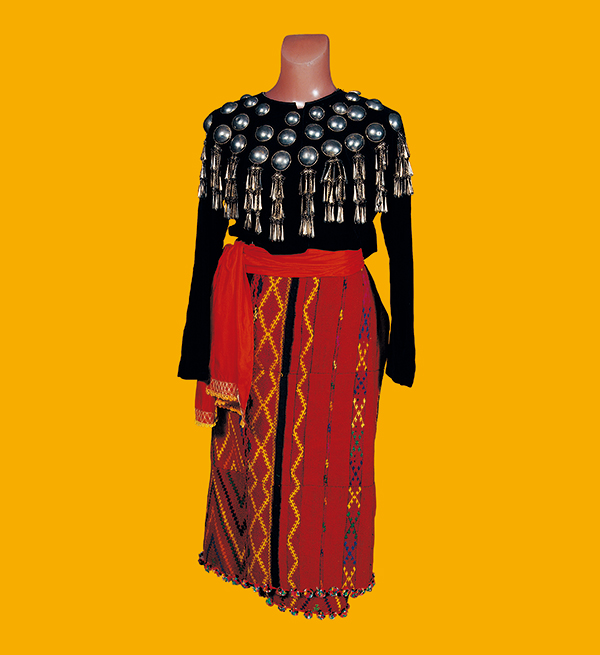
银泡衣毛毛织筒裙女服
景颇族·民国·云南陇川
筒裙用羊毛手工织成,以枣红色和菱形几何花纹为特色。
The tight skirt is made of wool, normally featuring geometric pattern embroidered with burgundy thread.

绣花土布女服
傣族·民国·云南元江
傣族直系之一“花腰傣”族传统服装,用自织自染青黑色土布制成。上衣短小紧身,内衣圆领无袖,领缘、胸前及下摆缀银饰。外衣无领无扣,下摆绣花,袖口镶彩色布条。下穿长筒裙1至3条,里长外短,露出底边所绣的花纹,绣花下摆依次错开。穿裙时必须从头顶往下套,不能从脚往上穿。穿好后裙摆应该左高右低。腰间用宽彩带缠束,既可系裙,又可饰腰,“花腰”之名即由此而来。
This dress would have been worn by Huayao woman, a branch of the Dai in Yunnan. The name "Huayao" means "Colorful Waistband" and they get their name from colorful costumes like this one. The bolero, shorter than the waistband, is trimmed with embroidery along the collar, cuff and hem.Huayao Dai women usually wear three tight skirts, with the longer ones underneath so that each layer shows. Traditionally, this skirt should be worn higher on left than on the right.
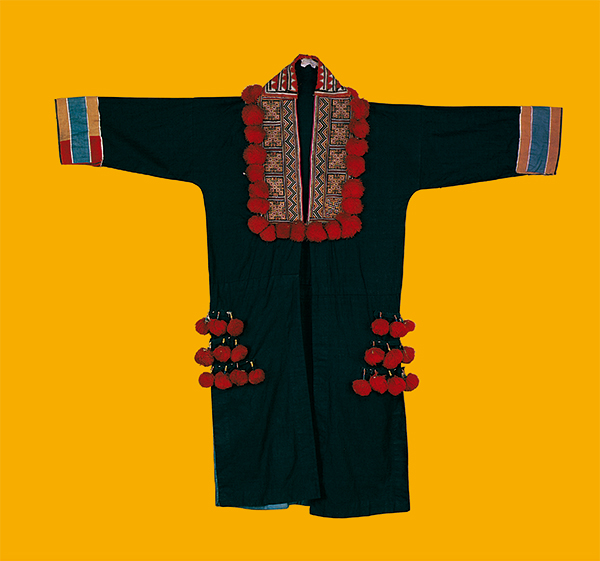
青布挑花女上衣
瑶族·民国·广西荔浦
瑶族土布对襟长衣,前襟上部挑绣花边并缀红色毛线球多枚,领后缀紫线穗。
This coat is made of homespun cloth, and decorated with embroidered lace and several red balls of yarn on the front lappels, while purple tassels hang from the back of collar.
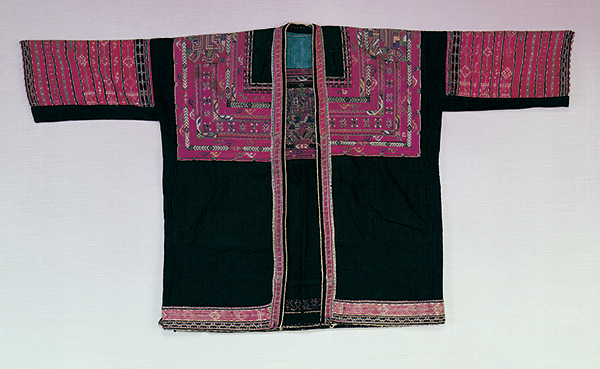
彩绣女上衣
瑶族·民国·广东
瑶族青色土布、彩线绣花女上衣。
This coat is made of cyan homespun cloth, and is decorated with floral patterns embroidered using colored threads.

鸡爪谷草裙
珞巴族·民国·西藏珞瑜
此裙用鸡爪谷秸秆编制而成。过去珞巴族米里部落和德根部落的妇女曾普遍穿着此裙。现在布裙虽已普及,但劳动之时人们仍喜欢内穿布裙,外罩草裙。这样,既保护了布裙,又使传统习惯得以延续。
The Lhoba skirt is made from the straw of finger millet (Eleusine coracana) which is locally called "Chicken claw millet" because the ear of grain splits into three claw-like appendages on the stalk. In the past, women in the Mili and Genhe tribes of the Lhoba used to wear skirts like this one. Today cloth skirt are more practical, however, it is not uncommon for women to wear grass skirts over their modern clothing.

贯头式氆氇女服
珞巴族·民国·西藏珞瑜
此女服用黑色氆氇缝制而成,坎肩式无领、无袖长衣。上端中间开一椭圆形口作为领口,穿时从头顶套下。肩沿和底边镶三角形金丝缎为饰。
This sleevelss gown is made of black wool.The shoulder and hem are trimmed with golden brocade.

贯头式氆氇男服
珞巴族·民国·西藏珞瑜
坎肩式黑色氇氇贯头长衣。是将两块窄幅长条氆氇从中间对折后拼缝在一起,上端中间留30多厘米长的口作领口,穿时从头上套下。腰饰金属链条和缀满贝壳的腰带。
This black woolen pullover dress is sewn from two long pieces of wool, leaving 30cm open on the top as a collar. The waist is decorated with metal chains and seashells.
